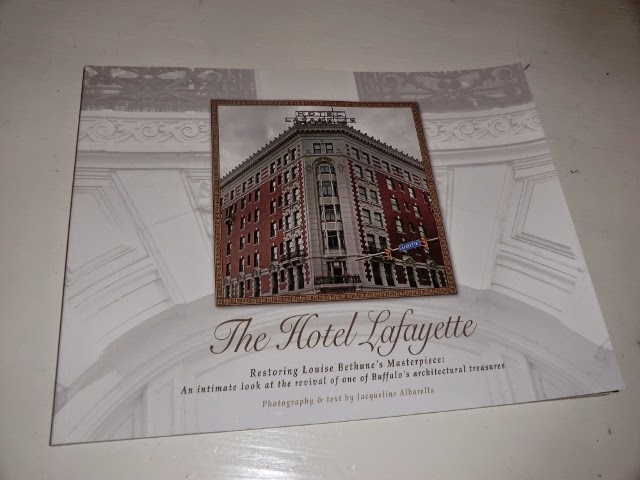Documentary film maker and author Jacqueline Albarella visited the Grand Island Historical Society yesterday to do a presentation on the restoration of the Hotel Lafayette. She spent two years photographing the work in progress. She has written a book and has made a documentary film of the project. If you are interested in buying the book, you can find it at Talking Leaves Books, Borders, Viddlers, Woyshners Florist, and the Buffalo History Museum.
 |
| Jackie Abaralla’s book about the restoration of the Hotel Lafayette, full of colorful pictures, depicting one of Buffalo’s great masterpieces. |
 |
| Jackie Abarella discusses the massive project that she was able to witness and document from start to finish. |
The Hotel Lafayette in downtown Buffalo was considered to be one of the ten best hotels in the United States not long after its grand opening in 1904. Each room featured hot and cold running water and telephones. These days, we don’t really think of those things but they were a big deal three years after the Pan American Exposition in Buffalo, which celebrated the magical powers of electricity. Unfortunately, the Pan American Exposition ended badly, with President McKinley dead after being shot by an assassin outside of the Temple of Music. He didn’t die from the assassin’s attack. He actually died as a result of botched surgery (the doctor performing the surgery was a gynecologist, not a surgeon).
Anyway, back to the Hotel Lafayette. It was designed by Louise Bethune, who was the first woman to become a member of the American Institute of Architects. This building was the masterpiece of her life. It was filled with treasures… paintings, beautiful big windows, detailed plastering, and more. It was one of many architectural gems of Buffalo, which included the Guaranty Building by Louis Sullivan, the Darwin Martin House by Frank Lloyd Wright, the park system by Frederick Law Olmsted, etc. The Hotel Lafayette was a bright, glittering gem in a city that had a robust economy, as a result of commerce along the Erie Canal.
Unfortunately, as the years went by, the Hotel Lafayette mirrored Buffalo’s decline. When the Erie Canal proved to be too small for larger ships, the Saint Lawrence Seaway and the reconstructed Welland Canal were built. The seaway is a series of locks, canals, and channels that permit large ships to travel from the Atlantic Ocean to Lake Superior. Unfortunately, Buffalo was bypassed. Buffalo was a has-been and the the Queen City’s crown was tarnished. The Hotel Lafayette, too, did not prosper. It was remodeled several times but it fell into disrepair and was eventually abandoned and left for dead. The decaying building became a transient hotel and then a welfare hotel. After it was abandoned, squatters moved in.
So… enter Rocco Termini of Signature Development Corporation. He purchased the former gem of downtown Buffalo with the idea of restoring it to its former glory. Early in the project, documentary filmmaker Jackie Albarella asked Mr. Termini if she could take pictures. She went to take pictures one day… and another day… and she ended up by taking pictures every day for two years. She said that she “captured the building’s restoration in still photographs.”
Here are her impressions of the experience:
- Buffalo’s artisans brought the Hotel Lafayette back to life. The plasterers used original 1901 techniques.
- The exterior did not need a lot of work. Jackie mentioned an upper corner with loads of detail plaster work.
- It was decided not to wash the outside of the building. Power washing brick damages it.
- After numerous renovations, much of the original work had been covered up. Much of the downstairs had been painted in Pepto Bismol pink.
- The building was leaking. The result of all of that dampness was a great deal of water damage and paint peeling off in sheets.
- In the basement, there had been a speak easy. It seems that the funding for the construction of the Hotel Lafayette had come from Walter Duffy, owner of Duffy Malt Liquor.
- A huge painting by Abbot Fuller Graves, who was known for painting garden scenes and flowers, has cleaned by hand by art conservationists. The large painting was nailed into the wall but, even so, someone had tried to pry it off.
- There was a good deal of scagliola in the walls. Artists repainted it by hand. It was called the “poor man’s marble.” It is a form of plaster that is designed to look like decorative stone. “It looks like marble and feels c ool to the touch.”
- Types of wood used in the construction of the original Hotel Lafayette include Moroccan oak, walnut, and chestnut. In the restoration, one man did most of the woodwork.
- In the 1940s, the lobby was redone in a style called Art Moderne. The original style of the hotel was French Renaissance.
- The Grand Hallway was originally known as “Peacock Alley” because women dressed up and stolled down the promenade, sort of like peacocks showing off their feathers.
- The hotel had been a city unto itself, with all sorts of services available. People never had to go outside if they didn’t want to.
- The oldest plasterer, who was nicknamed Hot Shot, was 14 years old when his uncle taught him the craft. During the project, he celebrated his 90th birthday.
- All of the craftsmen were happy when they worked long hours restoring the hotel. “For us, this is a once-in-a-lifetime opportunity,” they told Jackie.
- The building was named the Hotel Lafayette for a reason. Art conservators restored a painting of General Lafayette.
interesting!